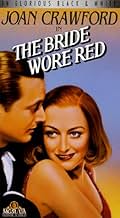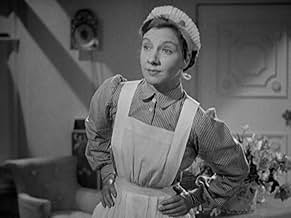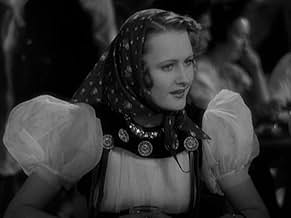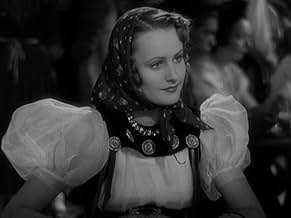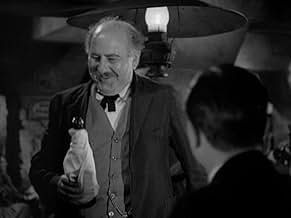AVALIAÇÃO DA IMDb
6,3/10
1,3 mil
SUA AVALIAÇÃO
Adicionar um enredo no seu idiomaA lounge singer is sent by a count to pose as a wealthy socialite.A lounge singer is sent by a count to pose as a wealthy socialite.A lounge singer is sent by a count to pose as a wealthy socialite.
- Direção
- Roteiristas
- Artistas
Mary Philips
- Maria
- (as Mary Phillips)
Rafael Alcayde
- Hotel Clerk
- (não creditado)
Nino Bellini
- Cosmos Club Waiter
- (não creditado)
Agostino Borgato
- Cordellera Bar Waiter
- (não creditado)
Adriana Caselotti
- First Peasant Girl
- (não creditado)
Robert Cauterio
- Hotel Clerk
- (não creditado)
Irene Coleman
- Cosmos Club Hat Check Girl
- (não creditado)
Gino Corrado
- Cosmos Club Croupier
- (não creditado)
Avaliações em destaque
Joan Crawford stars in "The Bride Wore Red," a 1937 MGM film based on the play by Ferenc Molnar. Here, it's directed by Dorothy Arzner. Arzner was a fascinating woman - a female director amid a sea of men - very much ahead of her time in her dress, profession, and lifestyle, and highly intelligent. Was she a great director? Hard for me to say. I don't think she always got the best scripts. And in Crawford, she had a headstrong star as well.
The story concerns a poor girl, Anni (Crawford) who sings in a sleazy café (read: with prostitution as a sideline)in the red light district of Trieste. A count she meets believes that the only thing separating the rich from the poor is money - it's not class, it's not breeding, it's not education. To make his point, he sends Anni to a fabulous resort with beautiful new clothes for two weeks. Anni meets Rudi (Robert Young), from an excellent and wealthy family, but he's engaged. With time short, Anni decides that it's Rudi she wants, and is determined to stick it out as long as necessary to get him. But it's not only a lack of funds and Rudi's fiancé standing in her way - it's also the postman, Giulio (Franchot Tone).
Crawford is beautiful, and this was the type of role she played continuously in the 1930s with great success. Tone, Young, and Billie Burke give her good support.
What is this business with the "no European accents" that someone mentioned? Actors do not use European accents when portraying foreigners in their own country or a nearby country. The characters aren't speaking English with a foreign accent in Poland, Switzerland, or Italy. They're speaking another language. If accents were necessary, all Chekov plays would be done with Russian accents. They aren't.
I thought for what this was, the film took a little too long to make its point and was a bit slow in spots. It's not the best Crawford film, but she gives a strong performance as a willful woman determined to marry money. As for Arzner's direction, apparently she couldn't get anywhere with Crawford, so I'll withhold judgment.
The story concerns a poor girl, Anni (Crawford) who sings in a sleazy café (read: with prostitution as a sideline)in the red light district of Trieste. A count she meets believes that the only thing separating the rich from the poor is money - it's not class, it's not breeding, it's not education. To make his point, he sends Anni to a fabulous resort with beautiful new clothes for two weeks. Anni meets Rudi (Robert Young), from an excellent and wealthy family, but he's engaged. With time short, Anni decides that it's Rudi she wants, and is determined to stick it out as long as necessary to get him. But it's not only a lack of funds and Rudi's fiancé standing in her way - it's also the postman, Giulio (Franchot Tone).
Crawford is beautiful, and this was the type of role she played continuously in the 1930s with great success. Tone, Young, and Billie Burke give her good support.
What is this business with the "no European accents" that someone mentioned? Actors do not use European accents when portraying foreigners in their own country or a nearby country. The characters aren't speaking English with a foreign accent in Poland, Switzerland, or Italy. They're speaking another language. If accents were necessary, all Chekov plays would be done with Russian accents. They aren't.
I thought for what this was, the film took a little too long to make its point and was a bit slow in spots. It's not the best Crawford film, but she gives a strong performance as a willful woman determined to marry money. As for Arzner's direction, apparently she couldn't get anywhere with Crawford, so I'll withhold judgment.
Dorothy Arzner is the director of this film, and though she does not make a lot of films, she usually makes rather substantial ones. This is certainly a substantial one.
The most appealing aspect of this production is the chemistry and loveliness of the couple played on screen by Joan Crawford and Franchot Tone (married in real life). This is not the only film that MGM has costarred them in together, but in this picture, it is easy to see the magic they create.
For his part, Robert Young is a worthy costar. And so is Joan's dazzling dress, referenced in the title. One must not forget to mention the always splendid Billie Burke, directed in several other pictures by Arzner. This time she portrays a real shrew, not her trademark scatterbrained character.
The most appealing aspect of this production is the chemistry and loveliness of the couple played on screen by Joan Crawford and Franchot Tone (married in real life). This is not the only film that MGM has costarred them in together, but in this picture, it is easy to see the magic they create.
For his part, Robert Young is a worthy costar. And so is Joan's dazzling dress, referenced in the title. One must not forget to mention the always splendid Billie Burke, directed in several other pictures by Arzner. This time she portrays a real shrew, not her trademark scatterbrained character.
In about 1980 I saw this film at the UCLA Film Archives in a series presenting Dorothy Arzner directed films. There was a guest speaker at the event who was a personal friend of Arzner's. I don't remember her name, but she was introduced as, among other things, the writer for the script of "Craig's Wife" (1936; starring Rosalind Russell).
She said she was on the set for some of the shooting of "Bride Wore Red," and described how Joan Crawford was completely uncooperative with the director. Originally it was written for Luise Rainer but for some reason she was unavailable. "So they got Joan Crawford who wasn't anything like her," and was not suited for the film in this woman's opinion. While she was on the set she witnessed how Dorothy Arzner would gently make suggestions as to how to play a scene, "...and Joan would scream, 'You'll destroy me! You'll destroy me!' and she would run up to L.B. Mayer and he would say, 'There, there Joan, play it your way." So she did, "...and frankly, the film bombed. But when you have a star that is entirely uncooperative, you can't blame the director." I hope I have quoted this woman accurately. That is what has stuck in my memory. I am a big Crawford fan, but her flaws were apparently spectacular. I just thought it would be interesting to record this bit of info.
She said she was on the set for some of the shooting of "Bride Wore Red," and described how Joan Crawford was completely uncooperative with the director. Originally it was written for Luise Rainer but for some reason she was unavailable. "So they got Joan Crawford who wasn't anything like her," and was not suited for the film in this woman's opinion. While she was on the set she witnessed how Dorothy Arzner would gently make suggestions as to how to play a scene, "...and Joan would scream, 'You'll destroy me! You'll destroy me!' and she would run up to L.B. Mayer and he would say, 'There, there Joan, play it your way." So she did, "...and frankly, the film bombed. But when you have a star that is entirely uncooperative, you can't blame the director." I hope I have quoted this woman accurately. That is what has stuck in my memory. I am a big Crawford fan, but her flaws were apparently spectacular. I just thought it would be interesting to record this bit of info.
The plot may not be a novel one, but the title was appetising and so were the cast. 'The Bride Wore Red' was seen as part of one of many completest quests (seeing as many films not yet seen of the person in question as possible), this one being for Joan Crawford. As well as Crawford, we have other talented performers in Franchot Tone, Robert Young, George Zucco and Billie Burke. All of whom are great when with good material and in the right roles.
Although 'The Bride Wore Red' is not among the best of all involved (all have also been far worse served) or one of the best of the genre, it is still well worth watching and has a lot of positive traits. It didn't deserve to be a flop. As far as Crawford's 30s films go, which were a mixed lot in quality, 'The Bride Wore Red' somewhere around solid middle, and anybody that loves romance and comedy individually and together are likely to (not guaranteed as not everybody has the same tastes for everything) find a lot to enjoy. The case with me.
Is 'The Bride Wore Red' perfect? No. The story, despite the premise actually being good, has few surprises and can be very silly with some suspension of disbelief needed at times later on. Also felt that the start was on the dull side but once the main plot kicks in properly there is a lot more energy.
Do agree that Anni's conflict with what she wants and what she has to give up could have gone into more detail, that could have been a fascinating angle and added so much to Anni's character and given her more heart.
Crawford, looking stunning, however gives it her all without over-acting to the point of overbalancing the rest of the cast or film. She doesn't phone it in either once the plot gets going, despite being on the cold side at the beginning. Tone has one of the more likeable characters and is charming and suave. Young has some of the more juicier lines and brings a nice edge and sophistication to them. Zucco is convincingly decadent and Burke is in an atypically shrews viper sort of role and plays it to the hilt.
Found the script to be amusingly droll and that it did sparkle. The story wasn't perfect but it had energy and charm and the chemistry between the cast was beautifully pitched, the three leads work more than convincingly together. 'The Bride Wore Red' looks great, especially Crawford's wardrobe and the luminous photography. Franz Waxman's score is sumptuous without being too loud or melodramatic. Dorothy Azner's direction is a bit bland and slow to begin with, but becomes more assured as the film goes along.
Summing up, nice enough if not mind-blowing. 7/10
Although 'The Bride Wore Red' is not among the best of all involved (all have also been far worse served) or one of the best of the genre, it is still well worth watching and has a lot of positive traits. It didn't deserve to be a flop. As far as Crawford's 30s films go, which were a mixed lot in quality, 'The Bride Wore Red' somewhere around solid middle, and anybody that loves romance and comedy individually and together are likely to (not guaranteed as not everybody has the same tastes for everything) find a lot to enjoy. The case with me.
Is 'The Bride Wore Red' perfect? No. The story, despite the premise actually being good, has few surprises and can be very silly with some suspension of disbelief needed at times later on. Also felt that the start was on the dull side but once the main plot kicks in properly there is a lot more energy.
Do agree that Anni's conflict with what she wants and what she has to give up could have gone into more detail, that could have been a fascinating angle and added so much to Anni's character and given her more heart.
Crawford, looking stunning, however gives it her all without over-acting to the point of overbalancing the rest of the cast or film. She doesn't phone it in either once the plot gets going, despite being on the cold side at the beginning. Tone has one of the more likeable characters and is charming and suave. Young has some of the more juicier lines and brings a nice edge and sophistication to them. Zucco is convincingly decadent and Burke is in an atypically shrews viper sort of role and plays it to the hilt.
Found the script to be amusingly droll and that it did sparkle. The story wasn't perfect but it had energy and charm and the chemistry between the cast was beautifully pitched, the three leads work more than convincingly together. 'The Bride Wore Red' looks great, especially Crawford's wardrobe and the luminous photography. Franz Waxman's score is sumptuous without being too loud or melodramatic. Dorothy Azner's direction is a bit bland and slow to begin with, but becomes more assured as the film goes along.
Summing up, nice enough if not mind-blowing. 7/10
Well, you can't blame Joan for trying. Always wanting to go beyond that glamorous clothes-horse/shopgirl-makes-good mold in which MGM so successfully cast her throughout the 1930's, she was always attempting to outreach her grasp. When Metro's Austrian star Luise Rainer backed out of making a film of Molnar's THE GIRL FROM TRIESTE, a dark photoplay about a prostitute sent on a masquerade in the Tyrolean Alps, Crawford grabbed it, hoping to get her teeth into a meaty role. Imagine her chagrin when Metro executives "improved" the piece to be more suitable for Crawford's image, taking the meat and guts with it. What emerged was an uncomfortable picture built on compromises in an attempt to graft a typical Crawford/Cinderella plot onto what is basically a nasty, mean little story. Registering far below the Crawford usual at the paybox, THE BRIDE WORE RED started her career to skid.
A closer look, however, reveals that not all of the edge has been softened from the piece. I wholeheartedly agree with the reviewer who calls this Joan's most underrated performance, and there is a reason we do not sympathize with this Cinderella. Crawford's Anni is cold and snappish, and has the potential to do real harm to some nice, decent folk. The film plays like the dark side of all of those rags-to-Adrian gown stories Crawford played in the Metro phase of her career, and CRAWFORD IS FULLY AWARE OF THIS. Although seemingly played straight, there is an irony underneath that tells us Crawford herself isn't crazy about Anni either. It's understandable that 1937 audiences did not warm to a Joan they couldn't root for (even her hair is cut into a severe, but stunning, pageboy), but it deserves real recognition now that we are removed from the era and have seen ALL the phases of Crawford's career. In many ways, it's a harbinger of the darker, icier roles she was to play at Warner Bros. and throughout the 1950's.
The performances are uniformly good, with George Zucco strong as the decadent, evil Machiavelli who sends Anni on her masquerade, but Crawford, for the most part, is the standout. Only in the early scenes of the film, when she attempts to portray Anni as a world-weary honky tonk singer (in what must have been the cleanest, most glamorous "dive" in all of Trieste!!) does she fail to convince.
(Ironically, Crawford's next film, MANNEQUIN, released early in 1938 and co-starring Spencer Tracy, was a strictly paint by the numbers Rags-to-Adrian tale, inferior to this, that found great favor with the movie-going public.)
A closer look, however, reveals that not all of the edge has been softened from the piece. I wholeheartedly agree with the reviewer who calls this Joan's most underrated performance, and there is a reason we do not sympathize with this Cinderella. Crawford's Anni is cold and snappish, and has the potential to do real harm to some nice, decent folk. The film plays like the dark side of all of those rags-to-Adrian gown stories Crawford played in the Metro phase of her career, and CRAWFORD IS FULLY AWARE OF THIS. Although seemingly played straight, there is an irony underneath that tells us Crawford herself isn't crazy about Anni either. It's understandable that 1937 audiences did not warm to a Joan they couldn't root for (even her hair is cut into a severe, but stunning, pageboy), but it deserves real recognition now that we are removed from the era and have seen ALL the phases of Crawford's career. In many ways, it's a harbinger of the darker, icier roles she was to play at Warner Bros. and throughout the 1950's.
The performances are uniformly good, with George Zucco strong as the decadent, evil Machiavelli who sends Anni on her masquerade, but Crawford, for the most part, is the standout. Only in the early scenes of the film, when she attempts to portray Anni as a world-weary honky tonk singer (in what must have been the cleanest, most glamorous "dive" in all of Trieste!!) does she fail to convince.
(Ironically, Crawford's next film, MANNEQUIN, released early in 1938 and co-starring Spencer Tracy, was a strictly paint by the numbers Rags-to-Adrian tale, inferior to this, that found great favor with the movie-going public.)
Você sabia?
- CuriosidadesDuring filming, an electrician fell from the catwalk high above the set, narrowly missing the film's star, Joan Crawford. Shooting was temporarily halted while the man was rushed to hospital. Crawford refused to resume production until she was assured that the man would be fully cared for, that he would remain on salary, and that his family would be provided for. Crawford also called the hospital each day afterwards for reports on his condition.
- Citações
Rudolph 'Rudi' Pal: In my opinion, most people prefer sardines to caviar because most people haven't tried caviar.
- Cenas durante ou pós-créditosDuring the opening credits, a music box is shown playing a tune in the background.
- ConexõesFeatured in The Romance of Celluloid (1937)
- Trilhas sonorasWho Wants Love?
(1937)
Music by Franz Waxman
Lyrics by Gus Kahn
Sung by Joan Crawford (uncredited) at the Cordellera Bar
Played throughout as part of the score
Principais escolhas
Faça login para avaliar e ver a lista de recomendações personalizadas
- How long is The Bride Wore Red?Fornecido pela Alexa
Detalhes
Bilheteria
- Orçamento
- US$ 960.000 (estimativa)
- Tempo de duração1 hora 43 minutos
- Cor
- Proporção
- 1.37 : 1
Contribua para esta página
Sugerir uma alteração ou adicionar conteúdo ausente

Principal brecha
By what name was Felicidade de Mentira (1937) officially released in Canada in English?
Responda

